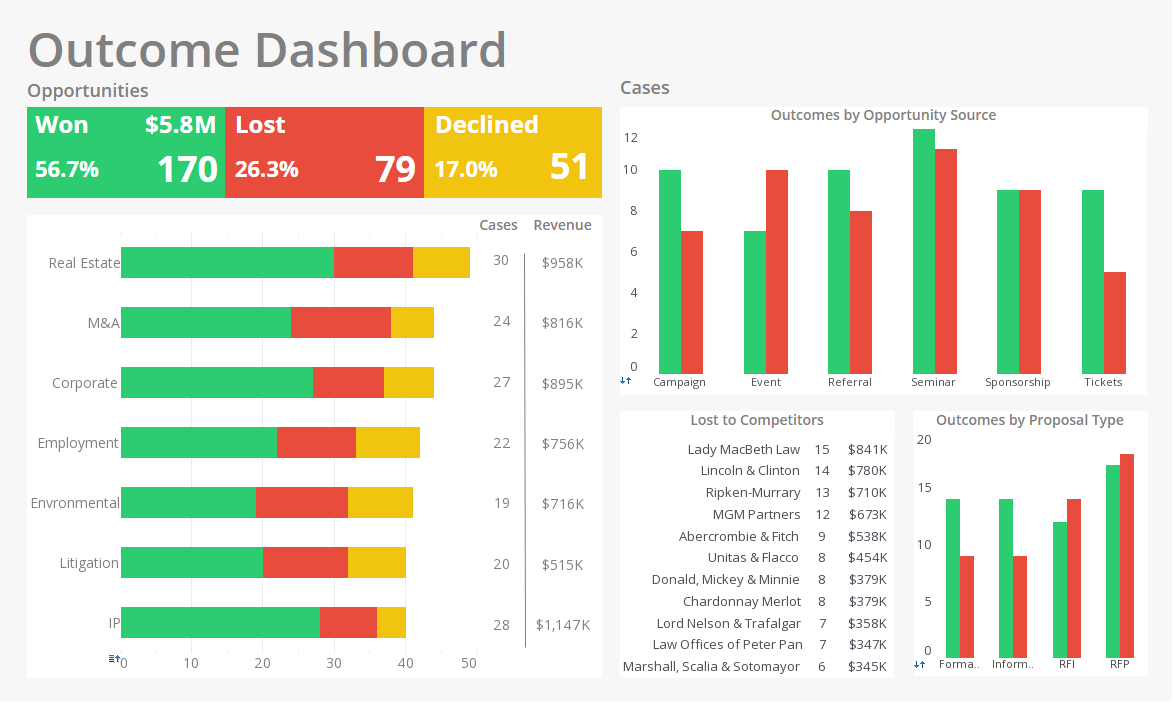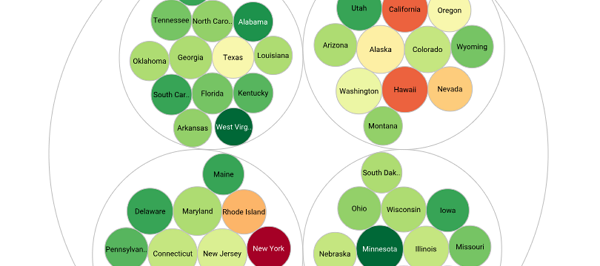BI Users at a Law Firm
This is the continuation of the transcript of a Webinar hosted by InetSoft on the topic of "Applying Analytics to Improve Performance in Law Firms." The moderator is Mark Flaherty, CMO at InetSoft.
Mark: So the different types of BI users at your law firm, you said quite a number of different reports and different kinds of users. I am guessing but I am assuming that some are looking at the reports on paper, some are printing them out? It would seem some of your analyst types probably use spreadsheets that work as well in that business intelligence environment, is that correct?
Ron: Yes, that’s right. Most of our partners would be getting PDF files. We still haven’t gone to the web versions of the reports. That’s always on our list, but we never seem to quite get to it. But certainly the partners get PDF type files, and our analyst type guys can get into the cubes themselves and into the transactions. So they have a mixture of hard copy reports and getting into the detail themselves.
Mark: So where do dashboards and visual analyses fit in the picture?
Ron: The new dashboards come out quarterly. The moment they come out, in two ways, they come out in hard copy and still there is a reason to have hard copy. You can scribble on it and write on that. But also, we send out electronic versions to them as well, so they are getting those.
They can open it up in a browser running on their PC or on a tablet, so it's with them all the time. And like I said earlier, we started rolling that out in September, and they come out each quarter. We just finished our review of the third quarter which was the March quarter. We finished reviewing that during April.
Mark: Let’s go ahead. I am just going to call one of your dashboards up on my machine. I am going to run this in the PC environment because it's kind of difficult to show the iPad in this particular forum. However, these reports as you said can work on either on laptops, through the browser or on the iPad environment or in fact any mobile device through a browser. Particularly in the iPads it's quite nice, and I assume some of your folks use it that way.
Ron: Absolutely, yes.
Mark: So Ron, if I understand right, this is a mock-up. It's not your real numbers, but it does show the reports as you would see them. So the numbers may not be real, but at least the kinds of reports are all as you use them now.
Ron: Yes, that's correct, Mark. We have got 24 clusters, but this mock-up version has just got four clusters. And we have put in there fictitious names for the lawyers and yes, some of the numbers have just been muddied up a bit so we can talk about them happily with people that are interested in seeing what we have done.
Mark: So this opening page here, the graphic that’s very nice, and it shows stage one, stage two, stage three. What is that concept about?
Ron: What happens is that if the cluster of attorneys meet the first five KPIs that we will look at in a minute, if they have met those then they progress to the second stage. They start off as a stage one and stay there if they are underperforming in any of those KPIs. As they progress then they tick off the first five KPIs, then they move to stage two.
Then there’s another three KPIs that become their main focus as a stage two performer, and then once they have ticked those off, they move to stage three. And the stage three groups would be ones who are preeminent in their area or floor and sort of a star, for lack of a better description.
So the idea is that the different teams or clusters would find out where they were, what KPIs they needed to focus on, and that starts to progress them, and as they progress then they move from stage one to stage two to stage three.
Different Types of BI Users at a Law Firm
Business Intelligence (BI) tools are increasingly valuable in law firms, where data from case management systems, billing platforms, and client databases must be analyzed efficiently. Different types of users engage with BI in distinct ways depending on their role and analytical needs.
1. Partners and Executives
Law firm partners and executives use BI to gain a high-level view of financial performance, case profitability, and client engagement. They rely on dashboards and executive reports to track revenue trends, billable hours, utilization rates, and strategic growth opportunities. Their focus is primarily on actionable insights that can guide decision-making, resource allocation, and business development. They often need concise, trusted KPIs presented with clear thresholds and trend context to support board reporting. Self‑service drilldowns to transaction‑level data let them validate insights without waiting on analysts.
2. Practice Group Leaders and Managers
Practice group leaders and department managers leverage BI to monitor workflow efficiency, case progress, and staffing performance. They analyze metrics like attorney workload distribution, matter cycle times, and client satisfaction scores. BI tools help them identify bottlenecks, allocate resources effectively, and ensure teams meet deadlines and financial targets. They also run what‑if scenarios to test staffing changes or evaluate the impact of business development activities on utilization and profitability. Regular alerts and scheduled reports keep them proactive by surfacing issues before they escalate.
3. Attorneys and Legal Staff
Attorneys and paralegals may use BI for more detailed operational or case-level analysis. For example, they might track discovery timelines, research efficiency, or client communication metrics. Access to interactive reports enables them to make data-driven decisions about case strategy, prioritize tasks, and optimize productivity. Practical integrations with case management and document systems let them link analytics directly to matter documents, speeding up research and billing tasks. Mobile-friendly visualizations and ad‑hoc query tools provide quick answers during client meetings or while preparing for court.
4. Financial and Administrative Teams
Billing, finance, and administrative staff are heavy BI users who require detailed reports for invoicing, revenue tracking, and compliance. They analyze accounts receivable, write-off trends, and departmental costs to maintain accurate financial records and optimize operational efficiency. BI tools streamline reporting, reduce manual spreadsheet work, and improve forecasting accuracy. These teams depend on audit trails and configurable dashboards to support regulatory reporting and internal audits. Automated reconciliation and nightly ETL processes reduce errors and free staff to focus on analysis and process improvement.
5. IT and Data Analysts
IT teams and data analysts support all other BI users by maintaining the platform, integrating data sources, and creating custom dashboards. They ensure data integrity, develop advanced analytics models, and provide technical guidance so other users can access insights easily and securely. They also manage security and access controls so sensitive client data is visible only to authorized users, and build reusable data models to reduce duplication. Continuous performance tuning, data lineage documentation, and user training are part of their remit to increase adoption and trust across the firm.

